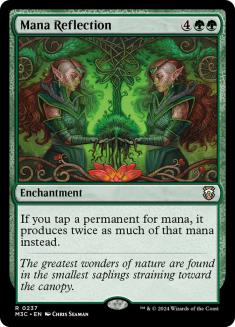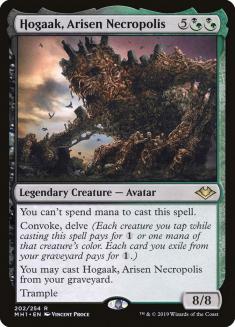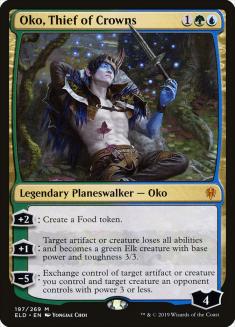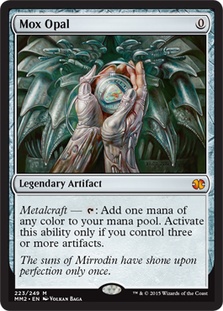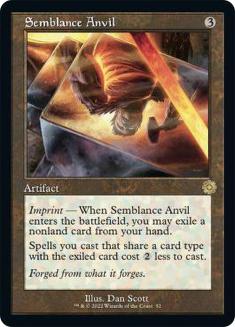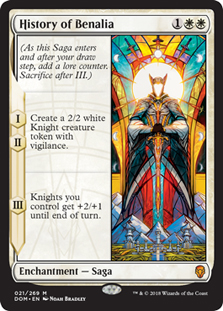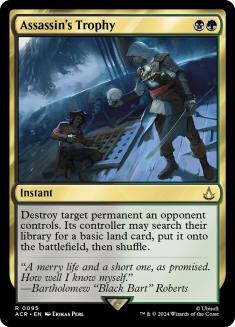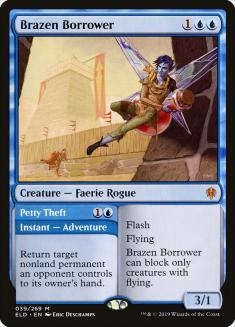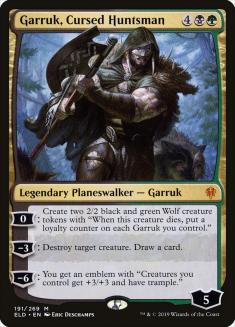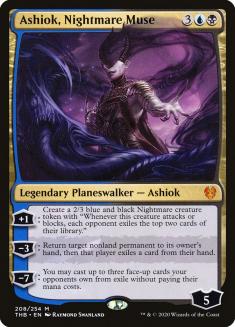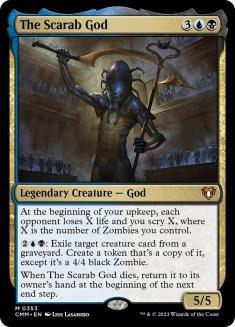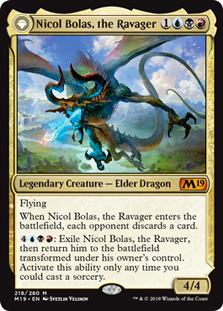Time is broken.
2019 seemed to go on forever, but it also feels like 2018 happened a week and a half ago. Maybe this is what it feels like to get older, or maybe the internet era has permanently removed all of us from any sort of meaningful temporality. Heck, I can’t even believe we’re ready to return to Theros — it feels like we just left.
Last week’s article was my 400th piece on Magic finance for Star City Games, an unbroken string of content that traces all the way back to March of 2012. I published my very first blog entry on Magic finance in March of 2009, which was more than a decade ago now. I’ve been writing this stuff for almost a full third of my life, which is just a bananas thing to realize about oneself.
Back in 2009, Magic finance was entirely different from how it is now. Trading was a far larger part of the game, and it wasn’t uncommon for dozens of trade binders to show up on the tables at your LGS between rounds. A few people had smartphones, but most people didn’t, and it didn’t really matter either way — most people weren’t terribly concerned with card values beyond their key staples, which didn’t fluctuate in price all that much.
In 2009, people played Vintage, Legacy, Extended, Standard, and Block Constructed. Commander was in the process of going wide, and Modern was still a few years away. There were large Prereleases and small Pro Tour Qualifiers. Mythic rares and planeswalkers were both still fairly new. Very few Standard cards ever sold for more than $20. Casual staples like Mana Reflection were worth less than a buck.
I’m delving into the past a bit today to remind all of us that times change. If I was still doling out the same Magic finance advice that I did back in 2009, I would have no place on this website. Evolution is important. Accepting and working through change is crucial. The only way to improve is to keep questioning our assumptions and moving forward.
To that end, here are my 15 Magic finance resolutions for 2020. They’re not all groundbreaking, but they are all important to navigating the world of Magic finance at the start of a new decade.
1. I Resolve to Have Less Fear of Change
There’s no way that 2009 me could have predicted all the ways that Magic has changed over the past decade. From Modern to Pioneer to Commander to Arena, the biggest forces driving Magic finance in 2019 didn’t exist ten years ago.
Nearly every major change in Magic has been met with a spark of fear. Modern was going to “kill the game,” and so were the removal of the damage on the stack rules, the double-sided cards, the Masters sets, the Buy-a-Box promos, the Organized Play changes, the other Organized Play changes, and Arena.
I’m not saying that all of these fears have been totally irrational. Things have changed a lot, and I’m sure that some of us would prefer that Magic today was a little more like it was back in 2009. But it’s important to recognize that “Magic is changing in ways that make me personally upset” is different from “Magic is dying.”
We all fear change, but change is inevitable. It is important to spend more time stepping back, looking at the big picture, and thinking about the best way to proceed with our Magic finance decisions regardless of our own personal stakes and emotions. No, that new format or new product line probably isn’t going to tank the value of your collection, but yes, Wizards of the Coast (WotC) printing more promos is likely to de-value some of the promos you already have. Try to keep your own fears from spiraling out of control whenever WotC announces something new and radical. Try to look for the opportunities instead of just bemoaning your potential losses.
2. I Resolve to Make More Bad Buys
The older I get, the more I’ve come to value the joy of having a deck that I like to play during a period of time when the metagame is fun and diverse. After a year of tournament play that was marred by cards like Hogaak, Arisen Necropolis and Oko, Thief of Crowns, this is an attitude that I’m sure many of you can relate to.
As the type of person who loves a deal, I’m always tempted to hold off on buying cards when I know the price will go down. If a deck looks fun but its key cards are expensive, I’m tempted to wait for the metagame to shift or the available supply of cards to increase, or else I’ll make some other excuse to hold off. Sometimes, this means that I’ll end up playing a sub-par deck for weeks or even months at the height of a really fun tournament season.
Being able to buy expensive cards at the top of the market is a privilege, of course, but it’s one worth exercising if you’re able to. You can recoup that money with smarter investments later on, but your favorite format won’t always be super-fun and diverse. Take advantage when you can.
3. I Resolve to Better Support My Community
Your favorite local game shop is a business. So are the folks that put on your favorite events.
Magic has never been as successful as it is right now, but a lot of those revenue streams have started to consolidate over the past few years. Local game stores don’t make money off Arena gems or direct-to-market products like Secret Lair. Nobody is funding tournaments or paying content creators based on the sale of Collector Boosters at Target or sealed boxes on Amazon.
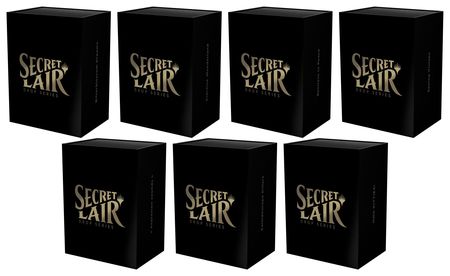
We all know that Magic is really about The Gathering, and supporting our community with your wallet is important. At the very least, I’ll be pausing to consider where my next booster box is going to come from rather than simply firing off a purchase order for the cheapest available copy.
4. I Resolve to Do a Better Job Selling into Hype
Intellectually, I understand that selling cards as soon as they spike is almost always the right call. It’s the “sell high” part of the phrase “buy low, sell high,” and without it, you’ll end up holding onto too many of your specs for too long.
Unfortunately, selling high comes with a few problems. First, it’s very tempting to get greedy. Cards rarely spike from $10 to $100 overnight; it generally takes a couple of weeks. And what happens if you sell a card at $30 and miss out on the next $100+ multi-format staple? If you pre-ordered Oko, Thief of Crowns at $25, you could have “sold high” at $40 in early October and missed out on Oko’s $70 peak.
Greed isn’t always the problem, though. If a card is surging in price, that’s usually because it currently looks unbeatable in some format or another. It feels bad to sell a card that’s useful and powerful, especially since it’s hard to tell how long it’ll remain a key part of the competitive metagame. Nobody wants to admit they sold their set of Mox Opals back in 2012 and missed out on almost a decade of playability.
That said, it’s often best to rip off the Band-Aid and sell into hype whenever possible. Looking back at the Magic market in 2019, it’s clear in retrospect that selling into each hot card’s initial price spike would have been the correct decision more often than not. Marquee planeswalkers like Oko and Teferi were the exceptions, not the rules. It’s worth knowing what these sorts of exceptions tend to look like (more on them later), but treating every flavor-of-the-month as a potential Teferi is a great way to lose a whole lot of money.
5. I Resolve to Price Cards Aggressively When I Sell Them
This goes hand-in-hand with my last resolution, but it’s an important enough point that I wanted to break it out and discuss it separately.
If you’re selling a scorching hot card like Oko was back in October or Teferi was back in May, you can pretty much wait for the market to come to you. But for smaller spikes, it’s better to price your cards below everyone else so that you can get out while the getting’s good.
I’ve seen some Magic Finance folks decry this mentality as a race to the bottom where everyone loses, and they’re not necessarily wrong. But it’s also going to happen whether or not you personally choose to participate. And if you’ve snapped up a few dozen copies of a card that was previously worth very little, it’s better to lock in some profits (and give someone else a good deal!) instead of holding out for top dollar and possibly losing out entirely.
Here’s a good example of what I’m talking about. Last February, Semblance Anvil spiked from $2 up to $15 and I told everyone to sell into the spike. I put a few sets up for sale at around $13/card, and nobody was interested. The price kept dropping, so I kept lowering my price to meet the market, but they kept refusing to sell. Finally, I cut my price all the way to $7 and they sold instantly. Today, Semblance Anvil retails for $4.
Point being, if you don’t think a spike is going to last, price it aggressively and move on. It’s better to lock in a smaller profit than risk no profit at all.
6. I Resolve to Buy the Eternal Staples I Need Before Tax Refund Season
Eternal cards almost always spike in February, March, and April. This isn’t a coincidence — a lot of the folks have US-based office jobs, and those jobs tend to come with moderately sized tax refund checks every spring. This leads to a sharp increase in demand for expensive eternal cards, which in turn causes higher prices.
There are other factors that play into the rise of eternal prices every spring — tournament schedules, set releases, and so on — but it’s a good rule of thumb regardless. If you’re going to invest in Vintage, Legacy, Modern, or Pioneer, you should buy in before mid-February if you can.
7. I Resolve to Spend More Time Researching Cutting-Edge Deck Design
Back in 2009, it usually took several days for a card to spike after a good showing in a major tournament. Back in 2015, you could spec on a card during Day 1 of a Pro Tour and have it pay off for you late on Day 2.
Both of those things still happen from time to time, but unknown decks rarely show up en masse at major events anymore. Heck, the fact that new sets release on Arena and Magic Online before they’re legal in paper means that there aren’t even that many surprises at the first SCG Open of the new Standard season anymore. Decks like Jeskai Fires and Jund Sacrifice first appeared on the Arena ladder and on the Magic Online 5-0 dumps, not at the tables of a major tournament. If you waited until they broke out, you would have missed out on the chance to buy in at a discount.
In 2020, I’ll be spending far more time mining the Arena leagues, combing through the Magic Online queues, and reading about the metagame innovations of my colleagues here on StarCityGames.com. It’ll be harder and riskier, but it’s also the only way to beat the market these days. We’ve got to stay sharp.
8. I Resolve to Focus More on Key Breakout Mythics
Four of the last five most recent non-Core Set Standard-legal sets were incredibly top-heavy. Dominaria was all about Teferi, Hero of Dominaria. Guilds of Ravnica was the Arclight Phoenix set. Ravnica Allegiance was the Hydroid Krasis set. Throne of Eldraine was the Oko set. If Teferi, Time Raveler had been a mythic rare, the same would have been true for War of the Spark. Heck, it almost was despite that.
This isn’t to say that there weren’t other valuable cards in these sets, from History of Benalia to Assassin’s Trophy to Breeding Pool to Brazen Borrower. I’m definitely not abandoning my complete set reviews, which have made me more money than all the rest of my columns combined. But I do think it’s important to realize that Standard finance is becoming increasingly dominated by a tiny handful of mythic rares, and the best thing you can do early on during preview season is to find the next key mythic. Hit on even one of them, and you’ve paid for your entire deck. However much time we currently spend trying to figure out the next chase mythic, it’s not enough.
9. I Resolve to Lean into “The Year of Commander”
Nintendo’s “Year of Luigi” may not have actually added up to much, but I believe WotC when they tell us that 2020 will be “The Year of Commander.”
Commander is already the most popular Constructed format in all of Magic, and it’s the most financially relevant as well. I’m sure I could list several thousand Magic cards that are only expensive due to Commander play, something that I can’t say about Standard, Pioneer, or even Modern. Commander is also the only format that doesn’t really translate well to Arena play, since it’s so dependent on table-talk and social contracts. I wouldn’t be surprised if WotC views Commander as their flagship tabletop format going forward.
Financially, this is going to be a bit of a double-edged sword. 2020’s focus on Commander is going to be massive: five new decks in April, two more in October, a new product called Commander Collection, and even a Commander draft set. That’s going to lead to a huge influx of new Commander players as well as some exciting new legendary creatures to build around, but it also means that there will be tons of reprints. Buying into Commander now is risky, but keep a close eye on the new decks and cards as they are revealed. I wouldn’t be surprised if the cards that spike due to the brand new Ikoria Commander decks are going to be among the most lucrative buys of the whole year.
10. I Resolve to Better Curate My Collection
A lot of people ask me questions like “Should I sell out of Legacy?” or “Should I trade my Modern staples for Pioneer staples?” and I never really know what to say. These are hard questions to answer, and the answers vary pretty wildly from person to person depending on their level of engagement, income level, collection size, and attachment to certain decks and cards.
We have moved past the era where it is realistically possible to try and own all of the Magic cards you will ever need. There are too many staples, too many formats, and the metagames are all constantly shifting. The same thing holds for collectors, who simply cannot keep up with every new frame, foiling process, and variant. WotC produces an overwhelming number of new cards each year, and that’s not going to change anytime soon.
In 2020, I’m going to spend more time curating my collection and less time simply hoarding cards. “Buy now, hold forever” used to be a pretty decent rule of thumb, but with all the different reprints and variants and formats and shifts in competitive play, that just isn’t nearly as true anymore.
I’m definitely not selling most of my eternal staples, but I see no reason to own a bunch of casual cards that aren’t in decks and are only worth money because they haven’t been reprinted in a while. Ditto for mid-level Modern cards that are only high due to low supply. As a rule of thumb, I’d like to avoid feeling blown out by reprints in 2020. The best way to do that is by selling cards that I don’t plan on using anytime soon.
11. I Resolve to Keep Going Against the Grain
As the endless parade of social media marches on, pervading almost every instant of our waking lives, it becomes a lot more tempting to simply agree with whomever is shouting the loudest or whatever conclusion the echo chamber has decided to rally around.
For instance, when I wrote my article about Oko’s post-ban financial future a couple of weeks ago, I second-guessed myself a lot because there was a thread at the top of the MTG Finance subreddit that was 1) incredibly popular, and 2) disagreed with almost every point I was trying to make. Over the next few days, I had to remind myself a couple of times that I’ve spent a long time studying this stuff and that I put in the time to properly research and consider the points in my article. Then I submitted my article and began to work on the next one.
In this particular case, I was right. The predictions I made in the article mostly came true, and the folks on Reddit were wrong. And, yeah, I know, the Reddit Hivemind is wrong about a lot on a pretty constant basis, but I still feel like the social media pressure to simply agree with the prevailing wisdom is something that a lot of us struggle with. It’s worth reminding yourself that you should feel confident in going against popular consensus and conventional wisdom when you’re an expert or you’ve done the necessary research. Just because there are a whole lot of other people on the other side doesn’t mean they’re right.
12. I Resolve to Admit When I’m Wrong
Failure is the greatest educational tool we have. Our brains are hard-wired to remember our mistakes and learn from them. That’s why our past social miscues suddenly pop back into the front of our mind when we’re driving or alone in the shower. It’s one of the crummier parts of being a human, but as long as those brain-patterns exist, we should take advantage of them.
Being wrong sucks, but you won’t get the benefit of improvement if you simply re-write your memories and pretend that you were right the whole time. This is something that I see happen a lot in the world of Magic finance, where (for example) the prevailing discourse on Oko, Thief of Crowns was that everybody knew Oko was broken from the start. After all, it was so obvious!
Well, I didn’t know that Oko was broken from the start. I had some guesses, but it wasn’t “so obvious” to me. Here’s the final three paragraphs of my Oko review from back in early September when the card was pre-ordering for $20:
If Oko only finds a home in Bant Ramp (or another, similar deck), then I suspect it’ll end up stabilizing around $15. This is the most likely scenario for the card, since three-mana planeswalkers are rarely complete busts, and this is one of the safest buys in the set right now. Turning $20 into $15 isn’t the greatest return on investment, but it might be worth it if you’re feeling lucky.
Besides, three-mana mythic planeswalkers have more financial upside than literally any other kind of card. I see no reason why Oko can’t end up at $50 if everything breaks right; after all, that’s what Liliana of the Veil sold for back when she was Standard-legal, and it’s less than what Teferi, Time Raveler would be selling for right now if he were mythic. Oko also shares a color identity with Hydroid Krasis, one of the most powerful cards in the format. If Oko ends up becoming the cornerstone of several decks—which is certainly possible—then you’re looking at one of the 2-3 most valuable cards in Standard.
Personally, I’m sticking by my prognostication of Oko as a $15 card by late November. It’ll be good, but not omnipresent. I just wanted to spend some time talking about the upside, because only a handful of cards in a given set have this kind of potential. If you’re an Oko believer, then $20 is a totally reasonable price to pay in order to see if your prediction comes true. I’m very intrigued at current retail.
There’s some pretty obvious hedging here, but I’m proud of myself for nailing Oko’s potential even if I didn’t actually think he’d live up to it. I’m especially proud of my Oko rundown compared to my review for Garruk, Cursed Huntsman, a card I was pretty harsh on despite the fact that it was pre-ordering for $10 more than Oko at the time. Ultimately, however, I just didn’t think that Oko was going to become the dominant multi-format all-star that it quickly became.
Here’s the thing, though — almost nobody called Oko that early. If they had, Oko wouldn’t have pre-sold for $20 while Garruk pre-sold for $30. People definitely liked Oko from the start, myself included, and some people started singing his praises pretty loudly as soon as they started testing with him. That took a couple of weeks, though, and there still wasn’t really anyone who predicted that Oko would be banned in multiple formats by the end of 2019.
My point here is neither to take a victory lap about Oko, nor self-flagellate over not correctly predicting his trajectory. I’m just saying that the “everybody knew Oko was broken from the start” narrative is wrong, and we can’t learn how to better evaluate cards in the future if we’re not willing to take a critical look at the past. Be willing to admit when you were wrong, and learn from your mistakes.
13. I Resolve to Take Losses in Stride and Avoid the Sunk Cost Fallacy
This goes hand-in-hand with my previous resolution. Sometimes, you’re going to speculate on a card and lose money. That’s just how it goes. Maybe you guessed wrong, or something got banned, or you got burned by a reprint, or you simply held too long. These things happen to everyone.
Dwelling on your losses doesn’t help. Believe me, I’ve tried. Shame is a powerful emotion, and it’s tempting to wallow in your losses, refuse to move on, and avoid further speculation along those same lines in order to protect your ego.
Literally none of this is helpful. If you don’t move on from your losses, then you can’t put the lessons that you’ve learned from your failure into action. This is especially true with Magic finance, which is mostly just a numbers game anyway. Even the best speculator in the world is going to take some losses — but if you’re good, your successes will more than make up for them. You just have to keep going.
It’s equally important to be constantly re-evaluating your failed specs. Sometimes it can make sense to hold them over the long haul, but there are plenty of other times when it’s better to lock in a small loss now instead of taking a larger loss later. Swallow your pride and try to keep looking ahead.
14. I Resolve to Keep Better Track of My Profits
If you speculate on Magic cards, you should have a spreadsheet that tracks your profits and losses. Profit margins are slimmer now than they used to be, and it’s more important than ever to make sure that you know which specs are actually making you money and which are not.
Whenever I’m fully organized, I have columns in my Magic finance spreadsheet that keep track of the price I paid for each card along with sellers’ fees and postage. Fees tend to be a percentage and postage is fairly flat, so you can generally estimate this stuff ahead of time once you’ve been doing this for long enough. That way, you’ll be able to figure out your potential profit margins on the fly when you’re making purchasing decisions.
Let’s say, for example, that you have an opportunity to buy a card for $4. You calculate your sellers’ fees at 14%, and your postage and supplies (top-loader, stamp, envelope, label) at 75 cents. If you want to make at least $1 in profit, you’ll have to sell that $4 card for a minimum of $6.69.
The nice thing about math is that it doesn’t lie. If you plug in all your numbers and keep track of them honestly, you’ll develop a really good sense of how much profit you’re making and how. It’s tempting to ignore your books sometimes in order to feel better about the bad decisions you’ve made, but ultimately the only person you’re hurting is your future self.
15. I Resolve to Keep Having Fun
Some days, it feels like the cycle of negativity surrounding the Magic community is inescapable. If Standard isn’t broken, then people are complaining about Modern prices, set release fatigue, the Reserved List, or changes to Organized Play. These issues are certainly worth talking about, but it’s also important to give it a rest sometimes and remember that we’re all here because we love the game of Magic and we want to have fun slinging cardboard with our friends.
I write this column because I want Magic to be more accessible for everybody. I haven’t gotten rich speculating on Magic cards, but I have gotten to the point where my speculation profits have paid for my entire collection. Without Magic finance, I probably wouldn’t have a Legacy or a Modern collection at all. I’ve had other people tell me that my advice has helped them gain access to formats that would have otherwise been outside their reach, and that always makes me incredibly happy to hear.
Magic was fun in 2009. It was fun in 2015. It’s fun now. Magic finance is still fun, too. There’s nothing like the feeling of hitting big on a spec target and turning that profit into a sweet new Commander deck, Modern staple, or Beta card that I don’t have yet. I love talking about market trends with people, I love mining rogue decklists for new tech, and I still love pulling out the old trade binder in between rounds at a tournament.
Sometimes, it’s important to shake off the negativity and remind yourself that we’re all here because we love this game and we want to spend as much time as possible immersed in the world of Magic. Being critical is fine, but so is letting loose and just…enjoying things. So in 2020, I resolve to at least try to spend less time complaining and more time having fun with the best game ever created.
This Week’s Trends
There have been a couple of exciting Theros Beyond Death previews this week, and I’ll be covering them in detail next week as I begin my detailed set review. I’ll also talk a little more about Elspeth, Sun’s Nemesis and Ashiok, Nightmare Muse now that we know their pre-sale price tags. Needless to say, they both have significant upside at their current pre-order prices of $20 each. While neither card seems destined to become the next Oko or Teferi, all new planeswalkers have the potential to become $60+ Standard all-stars these days. If your early testing reveals either of these cards to be above and beyond the current community consensus, you should snap up a set of them ASAP.
As more cards are revealed, I’ll be interested to see how pushed the multicolored Gods are for competitive play. During our last visit to Theros, the monocolored Gods shone in Standard while most of their multicolored counterparts were relegated to casual and Commander play. Devotion requirements tend to be harder to reach in multicolored decks, where it’s harder to find permanents with a lot of relevant mana pips in their casting costs. That isn’t to say that a card like Klothys, God of Destiny won’t be a powerful card in Standard, but I’d be careful about assuming that it’ll be easy to activate its creature mode.
Speaking of multicolored Gods, The Scarab God is the latest Pioneer card to spike. This is a result of the Grixis Control decks that have been popping up on Magic Online lately. They’re still quite new and there isn’t a ton of 75-card consistency yet, but most of them run The Scarab God in addition to Nicol Bolas, the Ravager; Kalitas, Traitor of Ghet; and Jace, Vryn’s Prodigy.
The Scarab God and Nicol Bolas, the Ravager both gained quite a bit of ground this week, with The Scarab God jumping about $15 while Nicol Bolas, the Ravager is currently sold out at $30. Interestingly enough, however, neither Kalitas nor Jace has gained any ground at all. Granted, both of those cards spiked earlier in Pioneer’s lifespan, but you’d think that a new home for both of these cards would at least warrant a couple of small gains. This is especially true for Kalitas, since Mono-Black Aggro has once again found its footing in the Pioneer metagame. At any rate, I wouldn’t be shocked if Kalitas and Jace, Vryn’s Prodigy end up increasing in value early in the new year.
Of course, the most interesting Theros Beyond Death preview of the week was a mere common last time around. Gray Merchant of Asphodel was a powerhouse in Theros Standard, a format where Mono-Black was solid deck choice for almost a full calendar year. I don’t know if that’ll happen again — WotC might not give the Gray Merchant nearly as many supporting pieces in 2019 — but I’d start picking up potential inclusions before all the speculators return from their holiday reverie. Ayara, First of Locthwain seems like the best call here, with cards like Rankle, Master of Pranks and Cavalier of Night set to start gaining as well.

